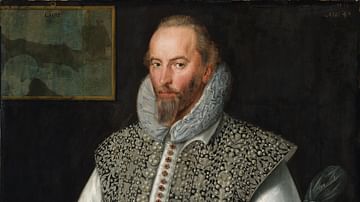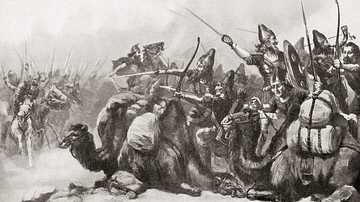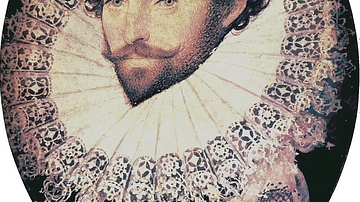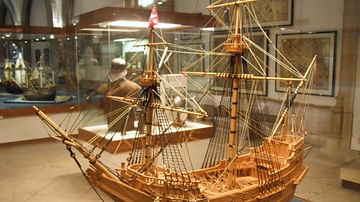
El Dorado ('Gilded Man' or 'Golden One') referred to the legendary kings of the Muisca (Chibcha) people who populated the northern Andes of modern-day Colombia from 600 to 1600. The name derives from the coronation ritual when the new king was covered in gold dust before he leapt into Lake Guatavita.
Over time, El Dorado extended its meaning to refer to a lost mythical city and even an entire region. When the Spanish Conquistadors heard these incredible tales of a city of gold they tried every means possible to find it. Ultimately though, the Spanish, and the explorers and treasure hunters who followed them, never did find the fabulous treasures of El Dorado.
The Significance of Gold
In the cultures of ancient Colombia gold had long been a popular material for metalworkers. The metal actually had no particular value as currency other than as a raw material for exchange and, indeed, it seems that, unlike in other Americas cultures, gold was not limited to the nobility but also owned by lower strata of society. Rather than its intrinsic value, then, gold was esteemed because of its lustre, incorruptibility, spiritual associations (especially concerning the sun), and workability in the hands of craftsmen. Skilled Muisca artisans produced stunning works of art using the full range of the goldsmith's repertoire, especially the lost-wax technique.
Gold and gold alloy artworks were offered in vast quantities to the gods and buried at sacred locations so that the balance of the cosmos was maintained and natural disasters averted. Very often the offerings were figurines known as tunjos which represented in fine detail people carrying objects such as shields, weapons and musical instruments. The most famous example of a tunjo is a golden raft with cast figures wearing jewellery standing upon it, the significance of which is discussed below. The raft was found in a clay vessel inside a cave and it now resides in the Museo del Oro in Bogotá.
So driven were they by their thirst for riches, the official Spanish government objective of exploration in northern South America was, in fact, to find gold, melt it down and ship as large a quantity as possible back to Europe. The association between ancient Colombia and the precious metal is further reflected in the Spanish King's choice of name for his new territory: Castillo del Oro. Of all the stories of gold and emeralds scattered across ancient Colombia there was one particular tale which especially aroused the interest of the Spanish invaders. This was an account, reported by eye-witnesses, which involved the lavish ceremonies performed during the coronation of a Muisca king.
The Gilded Man
The legend of El Dorado appears in most Spanish accounts of the region's conquest such as Fernández de Oviedo's Historia general y natural de las Indias (1535-48) but was later documented in greatest detail by Juan Rodriguez Freyle in 1636 CE, who claimed to have been told the details by the nephew of the last ruler of Guatavita. One of the oldest representations of the legend in art comes from an engraving of 1599 by Theodor de Bry which shows two attendants applying gold to the body of a third individual.
According to the legend, then, amongst the Muisca, when it was necessary to crown a new monarch, the man who would be king prepared for his great day with a period of abstinence. Secluded in a cave, he was forbidden chilli peppers, salt and women. When the coronation day finally arrived the future king travelled to Lake Guatavita, a remote lake formed in an extinct volcanic crater just north of modern-day Bogotá, in order to give offerings to the gods so that they might bless his reign. This he did by going to the centre of the lake on a raft. The raft, made from reeds, was laden with treasures of gold and emeralds and on it were placed four large incense burners. The incense was moque and the braziers, joined by those set around the shores of the lake, gave off clouds of thick smoke which must only have added to the mystique of the ceremony.
The most fantastic treasure of all, though, was the royal person himself. He had been stripped naked and entirely covered in a sticky layer of resin on which was blown fine gold dust. The result was a sparkling man of gold; literally a 'gilded man'. Also travelling on the raft were four attendants, less spectacularly attired but still weighed down with heavy gold jewellery on any part of the body it could be hung from. The great moment came when, accompanied by mass trumpets and singing from the shores, the raft arrived in the very centre of the lake. At that moment silence fell on the crowd and the attendants threw the fabulous treasure of gold and jewels into the lake and the people on the shores also threw their golden offerings into the sacred waters. The climax of the ceremony came when the golden king himself leapt into the lake and when he emerged, cleaned of gold, he had become the king of the Muisca.
Later History
From Sir Walter Raleigh to 20th-century explorers, extravagant and costly expeditions to find the golden city of El Dorado and its riches have been mounted over the centuries but none have had success. In the 1580s Antonio de Sepúlveda had perhaps the most ambitious scheme to find the gold when he cut a slice out of Lake Guatavita's crater edge in order to drain the lake and find the treasure which must have accumulated on the lake bed from centuries of coronation ceremonies. Some gold artefacts were found around the edges of the lake but before the lake could drain completely a landslide blocked the cut and so the water level of the lake began to rise again. Faced with a mutiny from the local population, the Spanish were forced to give up their search for the mythical city.
Another ambitious expedition in 1909 involved the English company Contractor Limited. They too sought to drain the lake and they were more successful than the Spanish. The method this time was to dig a tunnel under the lake and drain it that way. However, when the lake was emptied another problem arose and this was that the soft mud bottom of the crater was too deep to support any weight. Even worse, the mud quickly baked in the sun and became cement hard. Returning to Bogotá for drilling equipment the treasure hunters must have been crestfallen when they got back to the lake because in their absence the mud had also solidified in the drainage tunnel, blocking it so that the lake had filled back up again. With no more money to continue the project the English, like the Spanish and countless others before them, were forced to abandon the project with only a handful of small artefacts taken from the edge of the lake.
The cumulative results, then, of these expeditions have been hugely disappointing. Some gold has been found, as too have stone beads and pottery, but nothing, so far, to match the fabulous riches described in the legend of El Dorado. Perhaps, though, this is fitting as, after all, the original owners of the gold and jewels had intended their offerings for the sun and for them to remain for all time where they were given, at the bottom of a lake in the remote mountains of Colombia.






